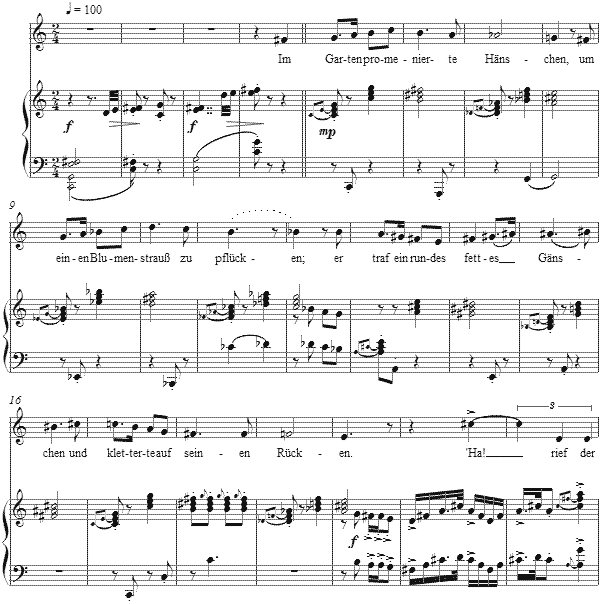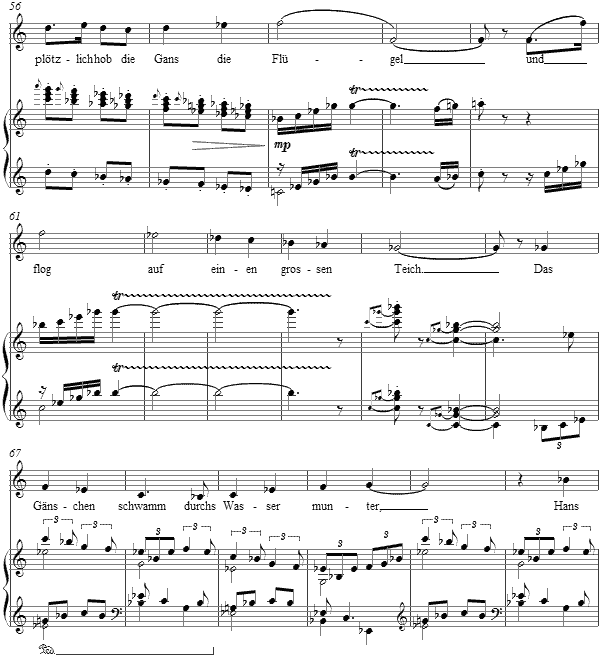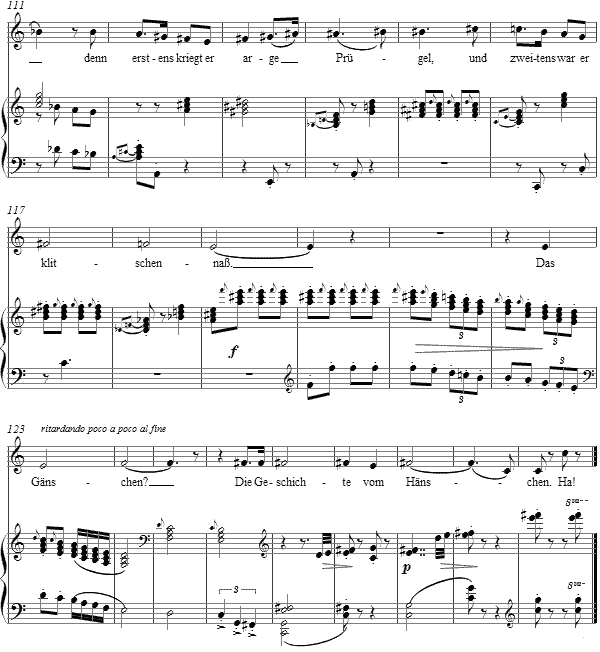Music and Texts of GARY BACHLUND
Vocal Music | Piano | Organ | Chamber Music | Orchestral | Articles and Commentary | Poems and Stories | Miscellany | FAQs
Die Geschichte vom Hänschen - (2009)
Joachim Ringelnatzfor medium voice and piano
Im Garten promenierte Hänschen,
Um einen Blumenstrauß zu plücken;
Er traf ein rundes fettes Gänschen
Und kletterte auf seinen Rücken.
'Ha!' rief der Hans, 'jetzt kann ich reiten.
Ich reite nach Amerika -
Dort gibt es keine Shularbeiten,
In vierzehn Tagen sind wir da!'
Ein Taschentuch nahm er als Zügel,
Der Sattel war bequem und weich,
Da plötzlich hob die Gans die Flügel
Und flog auf einen großen Teich.
Das Gänschen schwamm durch Wasser munter,
Hans strampelte und schrie zuletzt;
Das Gänschen tauchte dreimal unter
Und hat ihn dann ans Land gesetzt.
Hans kam nach Hause ohne Zügel
Und war vor Angst und Schrecken blaß,
Denn ertsens kriegt' er arge Prügel,
Und zweitens war er klitschenaß.[ 5 pages, circa 2' 40" ]
Joachim Ringelnatz
The text is drawn from a larger work of many poems from 1910, titled Was Topf und Pfann' erzählen kann. The text is rightly noted as written jointly by Hans Bötticher and Ferdinand Kahn, though my own suspicion is that this particular excerpt comes from the pen of Bötticher, whose pen name became, of course, the legendary Joachim Ringelnatz. Therefore in my setting I ascribe the text to his better known pseudonym, leaving it for scholars to perhaps correct me in some future time, if I err. In our time, all the printed anthologies under the name of Ringelnatz carry this work in toto. For other song settings to texts by this most amusing author, see the listing under R for Ringelnatz.
The Tale of Little Hans (in a rhymed paraphrase by the composer)
Through the garden went Little Hans,
To pluck some little flower;
He climbed upon a round, fat goose
To ride it through that bower.
'Ha!' cried Hans, 'now I can ride,
To America on this goose.
From school time lessons I can hide!
A few weeks, then I'll let it loose!
A handkerchief served him as reins,
The feather saddle was soft,
Until that goose with wings like planes
Flew little Hans aloft.
It landed in a pond well sized
And swam with greatest glee;
And so the fat, round goose baptized
Little Hans - once, twice, then three.
Hans came soaking home that day
All fussing; he'd been dipped!
He found in wait a spanking lay,
His bottom rightly whipped.
The opening chord progression of measures 5-8 make use of the entire twelve-tone scale, though in quite another way from the "system" so long advocated by a now passé devotion to early and mid-20th century dodecaphonic orthodoxy, found mostly in academia in my youth. The seeming character being "in C" of course falls apart as the next four measures move immediately towards E flat, the following four to A, and then a final set of gestures return to C only to be moved quickly into D. The next next stanza of the poem is a step higher, such that the continuing chromaticism moves far afield from any proposed tonic.
As the goose takes flight, so does the accompaniment, with rising gestures and trills in the upper reaches of the keyboard. This short flight comes down into the musical "water" of a tongue-in-cheek quotation from Wagner's Rheingold, as the voice drops to the lowest tessitura of the setting "under" the flowing triplets. The three submersions by the goose are characterized musically by three appearances of the theme, rising by half steps.
The song form structure is observed with a reprise marked come prima, and then the revisit to the harmonic scheme of the opening verse, before bending back into parallel "white key" triadic harmonies. The introductory gesture serves as a final, short coda to the setting, as the vocal part sings the title of the poem itself from the larger text, which in the original asks, "Kennt ihr die Geschichte vom Hänschen? Fragte aus der Pfanne das Gänschen."
The score for Die Geschichte vom Hänschen is available as a free PDF download, though any major commercial performance or recording of the work is prohibited without prior arrangement with the composer. Click on the graphic below for this piano-vocal score.



